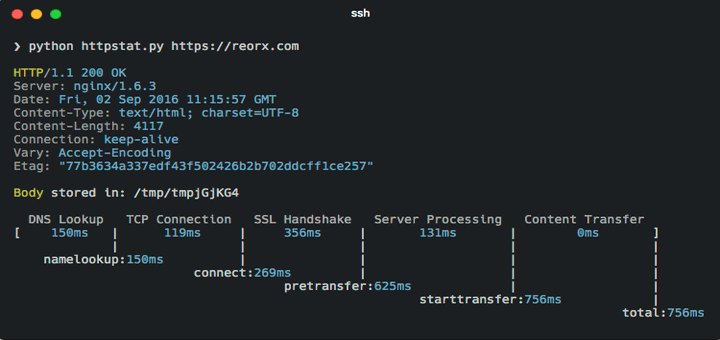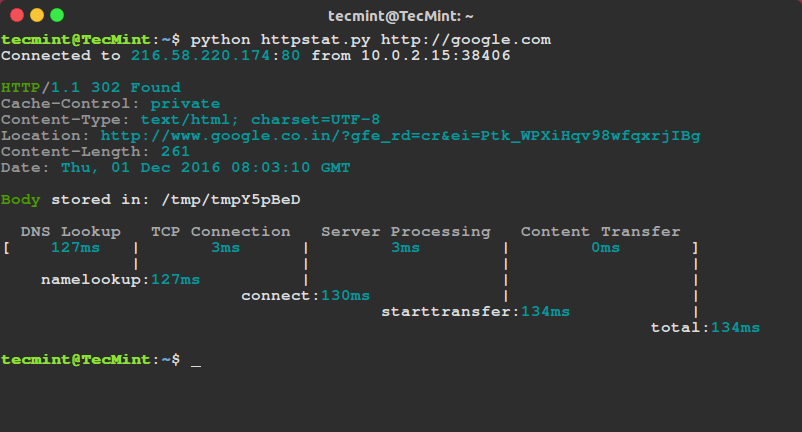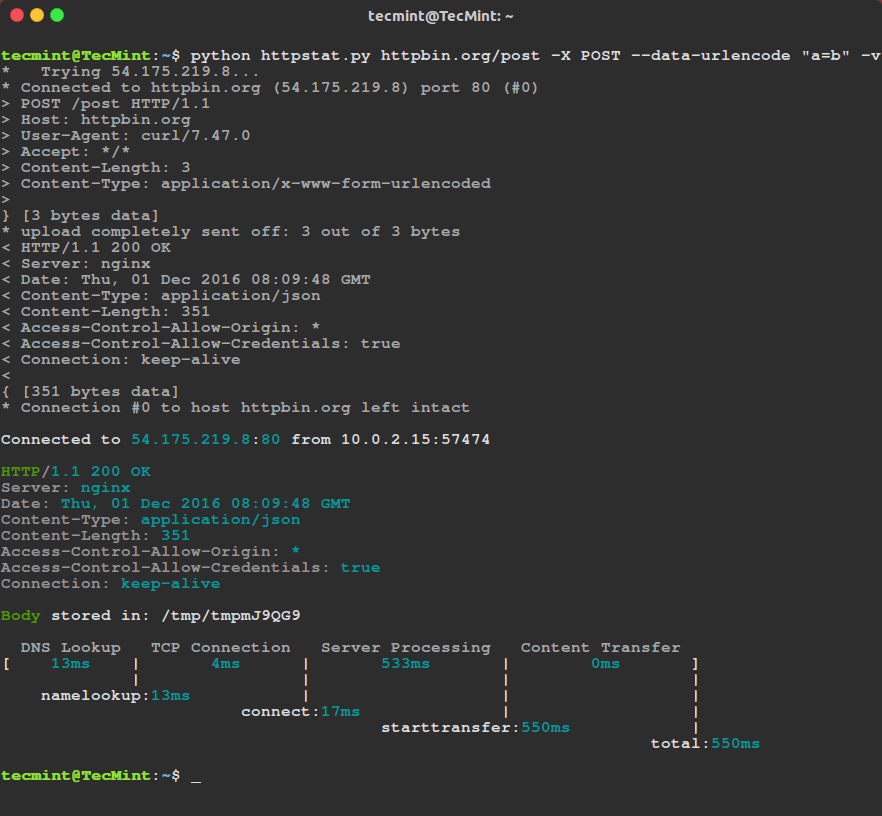mirror of
https://github.com/LCTT/TranslateProject.git
synced 2025-02-28 01:01:09 +08:00
168 lines
6.6 KiB
Markdown
168 lines
6.6 KiB
Markdown
httpstat – A Curl Statistics Tool to Check Website Performance
|
||
============================================================
|
||
|
||
httpstat is a Python script that reflects curl statistics in a fascinating and well-defined way, it is a single file which is compatible with Python 3 and requires no additional software (dependencies) to be installed on a users system.
|
||
|
||
It is fundamentally a wrapper of cURL tool, means that you can use several valid cURL options after a URL(s), excluding the options -w, -D, -o, -s, and -S, which are already employed by httpstat.
|
||
|
||
[
|
||

|
||
][5]
|
||
|
||
httpstat Curl Statistics Tool
|
||
|
||
You can see in the above image an ASCII table displaying how long each process took, and for me the most important step is “server processing” – if this number is higher, then you need to [tune your server to speed up website][6].
|
||
|
||
For website or server tuning you can check our articles here:
|
||
|
||
1. [5 Tips to Tune Performance of Apache Web Server][1]
|
||
2. [Speed Up Apache and Nginx Performance Upto 10x][2]
|
||
3. [How to Boost Nginx Performance Using Gzip Module][3]
|
||
4. [15 Tips to Tune MySQL/MariaDB Performance][4]
|
||
|
||
Grab httpstat to check out your website speed using following instillation instructions and usage.
|
||
|
||
### Install httpstat in Linux Systems
|
||
|
||
You can install httpstat utility using two possible methods:
|
||
|
||
1. Get it directly from its Github repo using the [wget command][7] as follows:
|
||
|
||
```
|
||
$ wget -c https://raw.githubusercontent.com/reorx/httpstat/master/httpstat.py
|
||
```
|
||
|
||
2. Using pip (this method allows httpstat to be installed on your system as a command) like so:
|
||
|
||
```
|
||
$ sudo pip install httpstat
|
||
```
|
||
|
||
Note: Make sure pip package installed on the system, if not install it using your distribution package manager [yum][8] or [apt][9].
|
||
|
||
### How to Use httpstat in Linux
|
||
|
||
httpstat can be used according to the way you installed it, if you directly downloaded it, run it using the following syntax from within the download directory:
|
||
|
||
```
|
||
$ python httpstat.py url cURL_options
|
||
```
|
||
|
||
In case you used pip to install it, you can execute it as a command in the form below:
|
||
|
||
```
|
||
$ httpstat url cURL_options
|
||
```
|
||
|
||
To view the help page for httpstat, issue the command below:
|
||
|
||
```
|
||
$ python httpstat.py --help
|
||
OR
|
||
$ httpstat --help
|
||
```
|
||
httpstat help
|
||
```
|
||
Usage: httpstat URL [CURL_OPTIONS]
|
||
httpstat -h | --help
|
||
httpstat --version
|
||
Arguments:
|
||
URL url to request, could be with or without `http(s)://` prefix
|
||
Options:
|
||
CURL_OPTIONS any curl supported options, except for -w -D -o -S -s,
|
||
which are already used internally.
|
||
-h --help show this screen.
|
||
--version show version.
|
||
Environments:
|
||
HTTPSTAT_SHOW_BODY Set to `true` to show response body in the output,
|
||
note that body length is limited to 1023 bytes, will be
|
||
truncated if exceeds. Default is `false`.
|
||
HTTPSTAT_SHOW_IP By default httpstat shows remote and local IP/port address.
|
||
Set to `false` to disable this feature. Default is `true`.
|
||
HTTPSTAT_SHOW_SPEED Set to `true` to show download and upload speed.
|
||
Default is `false`.
|
||
HTTPSTAT_SAVE_BODY By default httpstat stores body in a tmp file,
|
||
set to `false` to disable this feature. Default is `true`
|
||
HTTPSTAT_CURL_BIN Indicate the curl bin path to use. Default is `curl`
|
||
from current shell $PATH.
|
||
HTTPSTAT_DEBUG Set to `true` to see debugging logs. Default is `false`
|
||
```
|
||
|
||
From the output of the help command above, you can see that httpstat has a collection of useful environmental variables that influence its behavior.
|
||
|
||
To use them, simply export the variables with the appropriate value in the `.bashrc` or `.zshrc` file.
|
||
|
||
For instance:
|
||
|
||
```
|
||
export HTTPSTAT_SHOW_IP=false
|
||
export HTTPSTAT_SHOW_SPEED=true
|
||
export HTTPSTAT_SAVE_BODY=false
|
||
export HTTPSTAT_DEBUG=true
|
||
```
|
||
|
||
Once your are done adding them, save the file and run the command below to effect the changes:
|
||
|
||
```
|
||
$ source ~/.bashrc
|
||
```
|
||
|
||
You can as well specify the cURL binary path to use, the default is curl from current shell [$PATH environmental variable][10].
|
||
|
||
Below are a few examples showing how httpsat works.
|
||
|
||
```
|
||
$ python httpstat.py google.com
|
||
OR
|
||
$ httpstat google.com
|
||
```
|
||
[
|
||

|
||
][11]
|
||
|
||
httpstat – Showing Website Statistics
|
||
|
||
In the next command:
|
||
|
||
1. `-x` command flag specifies a custom request method to use while communicating with the HTTP server.
|
||
2. `--data-urlencode` data posts data (a=b in this case) with URL-encoding turned on.
|
||
3. `-v` enables a verbose mode.
|
||
|
||
```
|
||
$ python httpstat.py httpbin.org/post -X POST --data-urlencode "a=b" -v
|
||
```
|
||
[
|
||

|
||
][12]
|
||
|
||
httpstat – Custom Post Request
|
||
|
||
You can look through the cURL man page for more useful and advanced options or visit the httpstatGithub repository: [https://github.com/reorx/httpstat][13]
|
||
|
||
In this article, we have covered a useful tool for monitoring cURL statistics is a simple and clear way. If you know of any such tools out there, do not hesitate to let us know and you can as well ask a question or make a comment about this article or httpstat via the feedback section below.
|
||
|
||
--------------------------------------------------------------------------------
|
||
|
||
via: http://www.tecmint.com/httpstat-curl-statistics-tool-check-website-performance/
|
||
|
||
作者:[Aaron Kili][a]
|
||
译者:[译者ID](https://github.com/译者ID)
|
||
校对:[校对者ID](https://github.com/校对者ID)
|
||
|
||
本文由 [LCTT](https://github.com/LCTT/TranslateProject) 原创编译,[Linux中国](https://linux.cn/) 荣誉推出
|
||
|
||
[a]:http://www.tecmint.com/author/aaronkili/
|
||
[1]:http://www.tecmint.com/apache-performance-tuning/
|
||
[2]:http://www.tecmint.com/install-mod_pagespeed-to-boost-apache-nginx-performance/
|
||
[3]:http://www.tecmint.com/increase-nginx-performance-enable-gzip-compression-module/
|
||
[4]:http://www.tecmint.com/mysql-mariadb-performance-tuning-and-optimization/
|
||
[5]:http://www.tecmint.com/wp-content/uploads/2016/12/httpstat-Curl-Statistics-Tool.png
|
||
[6]:http://www.tecmint.com/apache-performance-tuning/
|
||
[7]:http://www.tecmint.com/10-wget-command-examples-in-linux/
|
||
[8]:http://www.tecmint.com/20-linux-yum-yellowdog-updater-modified-commands-for-package-mangement/
|
||
[9]:http://www.tecmint.com/apt-advanced-package-command-examples-in-ubuntu/
|
||
[10]:http://www.tecmint.com/set-unset-environment-variables-in-linux/
|
||
[11]:http://www.tecmint.com/wp-content/uploads/2016/12/httpstat.png
|
||
[12]:http://www.tecmint.com/wp-content/uploads/2016/12/httpstat-Post-Request.png
|
||
[13]:https://github.com/reorx/httpstat
|